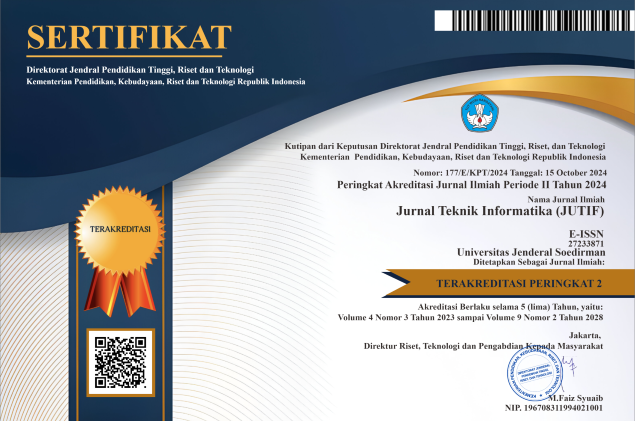AN EVALUATION OF THE SUCCESSFUL IMPLEMENTATION OF THE INFORMATION SYSTEM PLATFORM MERDEKA MENGAJAR USING HUMAN ORGANIZATION TECHNOLOGY FIT MODEL APPROACH
DOI:
https://doi.org/10.52436/1.jutif.2025.6.1.4282Keywords:
Evaluation Information System, Hot Fit Model, Merdeka Mengajar PlatformAbstract
The implementation of technology in education has great potential to improve the quality of learning that supports the implementation of the Merdeka curriculum. The Merdeka Mengajar platform (MMP) is designed to help educators by providing various features including self-development, inspiration and teaching. Uneven ICT infrastructure and teachers' personal abilities are problems in the implementation of the MMP, so it is necessary to analyze the success of the implementation of the MMP. The purpose of this study is to analyze the success of the implementation of the information system for the Merdeka Mengajar Platform by adopting the Hot Fit Model by expanding the Technology component with the ICT Infrastructure variable, expanding the Human component with the personal competence variable, expanding the organizational component with the organizational culture variable and the training & learning variable which can affect the successful implementation of the MMP. The data obtained were 328 respondents who were analyzed using SmartPLS 3.2.9. The analysis results obtained the proposed conceptual model has an accuracy of 58.6%. Net benefits are influenced by system use, user satisfaction, personal competence, structure, environment, organizational culture, and training & learning. Service quality, system quality, information quality, and ICT infrastructure have a positive impact on system use and user satisfaction.
Downloads
References
W. Sutarsih and T. Haryati, “Peran Digitalisasi Sekolah Terhadap Mutu Pendidikan,” Learn. J. Inov. Penelit. Pendidik. dan Pembelajaran, vol. 4, no. 2, pp. 288–295, 2024, doi: https://doi.org/10.51878/learning.v4i2.2810.
W. Lius Zen and Z. Trinova, “Development of E-Management for LMS Application Based Education,” J. Tek. Inform., vol. 3, no. 1, pp. 69–74, 2022, doi: https://doi.org/10.20884/1.jutif.2022.3.1.133.
M. Cholilah, A. G. P. Tatuwo, K. Komariah, S. P. Rosdiana, and A. N. Fatirul, “Metode Penelitian Pengembangan Bidang Pembelajaran (Edisi Khusus Mahasiswa Pendidikan dan Pendidik),” Sanskara Pendidik. dan Pengajaran, vol. 01, no. 02, pp. 56–66, 2023, doi: 10.58812/spp.v1.i02.
M. A. W. Wardana, D. P. Indra, and C. Ulya, “Analisis Penggunaan Aplikasi Merdeka Belajar Oleh Guru Bahasa Indonesia Di SMP Surakarta Sebagai Akselerasi Implementasi Kurikulum Merdeka,” J. Pendidik. Bhs. dan Sastra Indones., vol. 13, no. 3, pp. 209–220, 2023, doi: https://doi.org/10.23887/jpbsi.v13i3.69150.
R. D. Kurniawan, R. P. Avrianto, R. E. Indrajit, and E. Dazki, “Selection the Best Quiz Applications As Learning Performance Evaluation Media Using the Analytical Hierarchical Process Method,” J. Tek. Inform., vol. 3, no. 5, pp. 1389–1396, 2022, doi: https://doi.org/10.20884/1.jutif.2022.3.5.326.
S. H. H. Ilyas, S. H. Mansyur, and H. Harlinda, “Analysis of Learning Web Application Testing With Weighting Product and Ordered Weighting Averaging on Group Decision Maker,” J. Tek. Inform., vol. 3, no. 6, pp. 1513–1522, 2022, doi: https://doi.org/10.20884/1.jutif.2022.3.6.333.
K. P. Sari, S. Sariman, and M. Mujahidin, “Analisis Pemanfaatan Platform Merdeka Mengajar Untuk Peningkatan Kompetensi Guru Di Sekolah Menengah Atas Al Muhammad Cepu,” J. Pendidik. Al Fattah, vol. 3, no. 3, pp. 69–78, 2023, doi: https://doi.org/10.1989/dtfq7097.
N. Banna, R. Dewi, and D. Gasong, “Optimalisasi Pemanfaatan Platform Merdeka Mengajar dalam Pengembangan Proses Belajar Mengajar Bahasa Indonesia: Studi Kasus SD Negeri 11 Nanggala,” Indones. Res. J. Educ., vol. 4, no. 3, pp. 895–900, 2024, doi: https://doi.org/10.31004/irje.v4i3.912.
S. E. Dewi, A. Santoso, and R. S. I. Dewi, “Analisis Penggunaan Platform Merdeka Mengajar Pendukung Optimalisasi Merdeka Belajar Jenjang Sekolah Dasar,” Al-Madrasah J. Pendidik. Madrasah Ibtidaiyah, vol. 8, no. 1, p. 350, 2024, doi: 10.35931/am.v8i1.3096.
M. F. Rafli, F. Sidiq, R. Aprilia, J. Juliati, and A. K. Kenedi, “Pendampingan Optimalisasi Komunitas Belajar di SD Negeri Kabu di Platform Merdeka Mengajar ( PMM ),” J. Hum. Educ., vol. 4, no. 5, pp. 870–877, 2024, doi: https://doi.org/10.31004/jh.v4i5.1634.
L. Senduk, H. Karamoy, and L. Kalangi, “Pengaruh Kemampuan Personal, Kecanggihan Teknologi Informasi, Dan Dukungan Manajemen Terhadap Kinerja Sistem Informasi Akuntansi (Studi Empiris Pada Perusahaan BUMN Bidang Jasa Konstruksi di Kota Manado),” J. Ris. Akunt. dan Audit. “GOODWILL,” vol. 12, no. 2, pp. 194–206, 2021, doi: https://doi.org/10.35800/jjs.v12i2.36356.
A. D. Putra, “Penerimaan Platform Merdeka Mengajar Oleh Guru Di Kota Surabaya,” J. Penelit. Kebijak. Pendidik., vol. 16, no. 2, pp. 109–122, 2023, doi: https://doi.org/10.24832/jpkp.v16i2.772.
L. Fransiskus Erwinto Pati, S. Siswati, D. Sonia, and N. A. Rumana, “Evaluasi Implementasi Aplikasi Zi.Care dalam Pelaksanaan Rekam Medis Elektronik di Rumah Sakit Islam Jakarta Sukapura,” J. Ilm. JKA (Jurnal Kesehat. Aeromedika), vol. 10, no. 2, pp. 1–7, 2024, doi: https://doi.org/10.58550/jka.v10i2.286.
D. Lusiana and A. Nilogiri, “Model Hot Fit ( Human , Organization , Technology Fit ) Untuk Evaluasi Penerapan Aplikasi SATUSEHAT,” JSAI J. Sci. Appl. Informatics, vol. 06, no. 03, pp. 321–332, 2023, doi: 10.36085.
K. S. Kodoati and K. D. Hartomo, “Evaluasi Keberhasilan F-Learn Menggunakan Human Organization Technology (HOT) Fit Model pada Universitas Kristen Satya Wacana,” JATISI (Jurnal Tek. Inform. dan Sist. Informasi), vol. 9, no. 3, pp. 2096–2111, 2022, doi: 10.35957/jatisi.v9i3.2201.
B. Pertiwi and E. Yulianingsih, “Penerapan Model HOT Fit pada Evaluasi Kinerja Human Resources Information System ( HRIS ) di KPKNL Palembang,” J. Pengemb. Sist. Inf. dan Inform., vol. 1, no. 2, pp. 119–127, 2021, doi: https://doi.org/10.47747/jpsii.v1i2.171.
Z. R. A. Duhe, M. R. Katili, N. Pakaya, R. Yusuf, and A. Zakaria, “Evaluasi Sistem Informasi Kemahasiswaan Terpadu Menggunakan Model HOT-Fit,” Jambura J. Informatics, vol. 4, no. 2, pp. 70–81, 2022, doi: 10.37905/jji.v4i2.14664.
N. K. P. Gumay, R. Gernowo, and O. D. Nurhayati, “Analisis Pengaruh Model HOT-Fit Terhadap Pemanfaatan Sistem Informasi Kinerja Anggaran,” J. Teknol. Inf. dan Ilmu Komput., vol. 7, no. 4, pp. 823–832, 2020, doi: 10.25126/jtiik.2020743410.
W. Sari, M. H. Koniyo, and S. Olii, “Evaluasi Penerapan Sistem Informasi E-PPGBM Menggunakan Metode HOT FIT Model,” Diffus. J. Syst. Inf. Technol., vol. 3, no. 2, pp. 132–140, 2023, doi: https://doi.org/10.37031/diffusion.v3i2.20084.
D. Lusiana and A. Nilogiri, “Model HOT-Fit Pada Analisa Faktor-Faktor Penggunaan E-Commerce Berbasis Android,” Informatics J., vol. 8, no. 1, pp. 44–50, 2023, doi: https://doi.org/10.19184/isj.v8i1.35096.
B. Sugiyarto, O. M. Matandung, S. Silvia, V. Darurahmi, and M. Veranita, “Evaluasi Sistem Informasi Manajemen Rumah Sakit (Simrs) Metode Hot-Fit: Literature Review,” J. Soc. Econ. Res., vol. 6, no. 1, pp. 896–906, 2024, doi: https://doi.org/10.54783/jser.v6i1.395.
S. D. Purnamasari, F. Panjaitan, and T. Noviana, “Optimalisasi Penggunaan Media E-Learning pada Universitas XYZ menggunakan Model DeLone dan McLean,” J. Comput. Inf. Syst. Ampera, vol. 3, no. 3, pp. 141–155, 2022, doi: 10.51519/journalcisa.v3i3.196.
D. Saputra, A. Surniandari, and J. Sidauruk, “Implementation of DeLone and McLean Models To Measure The Success of Online-Based Tutoring System,” Bull. Comput. Sci. Electr. Eng., vol. 4, no. 1, pp. 8–23, 2023, doi: 10.25008/bcsee.v4i1.1180.
A. Yudiawan, S. Rokhmah, T. Umkabu, F. Safitri, and Arifin, “Factors Affecting the Success of E-Learning-Based Training using Learning Management System Platforms: Adaptations of Updated DeLone and McLean Models,” J. Educ. e-Learning Res., vol. 9, no. 3, pp. 192–198, 2022, doi: 10.20448/jeelr.v9i3.4186.
M. Mkinga and H. Mandari, “Evaluating Students Information System Success Using DeLone and McLean’s Model: Student’s Perspective,” J. Int. Technol. Inf. Manag., vol. 29, no. 2, pp. 24–42, 2020, doi: 10.58729/1941-6679.1447.
A. M. Sayaf, “Adoption of E-learning systems: An integration of ISSM and constructivism theories in higher education,” Heliyon, vol. 9, no. 2, p. e13014, 2023, doi: 10.1016/j.heliyon.2023.e13014.
W. Cidral, M. Aparicio, and T. Oliveira, “Students’ long-term orientation role in e-learning success: A Brazilian study,” Heliyon, vol. 6, no. 12, pp. 1–12, 2020, doi: 10.1016/j.heliyon.2020.e05735.
U. Ibrahim, “The Role of Cloud Computing in Transforming ICT Infrastructure in Educational Institutions,” Int. J. Appl. Sci. Res., vol. 2, no. 2, pp. 213–226, 2024, doi: 10.59890/ijasr.v2i2.1333.
S. S. A. Bin-Obaidellah, N. F. Mokhtar, N. A. Awi, and S. Mokhlis, “The Effect of ICT Infrastructure on Business Performance of Micro and Small Enterprises in Yemen: The Moderating Effect of Social Media Marketing,” Int. J. Procure. Manag., vol. 18, no. 1, pp. 44–67, 2023, doi: 10.1504/ijpm.2022.10047245.
H. K. Eliwa, M. B. Jelodar, and M. Poshdar, “Information and Communication Technology (ICT) Utilization and Infrastructure Alignment in Construction Organizations,” Buildings, vol. 12, no. 281, pp. 1–19, 2022, doi: 10.3390/buildings12030281.
U. Habiba and S. M. Z. Ahmed, “ICT Infrastructure and Access to Online Services: Determining the Factors Affecting Faculty Satisfaction with University-Subscribed Resources,” Int. Inf. Libr. Rev., vol. 53, no. 2, pp. 112–130, 2020, doi: 10.1080/10572317.2020.1794204.
A. M. Idkhan and M. M. Idris, “The Impact of User Satisfaction in the Use of E-Learning Systems in Higher Education: A CB-SEM Approach,” Int. J. Environ. Eng. Educ., vol. 5, no. 3, pp. 100–110, 2023, doi: 10.55151/ijeedu.v5i3.91.
H. Almaghrabi, B. Soh, and A. Li, “Using ML to Predict User Satisfaction with ICT Technology for Educational Institution Administration,” Inf., vol. 15, no. 218, pp. 1–23, 2024, doi: 10.3390/info15040218.
S. Rokhimah and A. Sirait, “Educator Satisfaction Using LMS with ICT Infrastructure as a Mediation Variable,” RSF Conf. Ser. Business, Manag. Soc. Sci., vol. 1, no. 3, pp. 81–87, 2021, doi: 10.31098/bmss.v1i3.291.
M. Tamimi, B. E. Soetjipto, S. Sopiah, and D. T. Kurniawan, “Budaya Organisasi dan Kinerja Karyawan:: A Systematic Literature Review,” Husnayain Bus. Rev., vol. 2, no. 2, pp. 11–21, 2022, doi: 10.54099/hbr.v2i2.100.
N. Khasanah, M. E. Perseveranda, J. S. Adrianus, P. Tule, and G. Djuang, “Pengaruh Budaya Organisasi , Dukungan Manajemen dan Kesiapan Pengajar terhadap Penerapan E-Learning pada Badan Pengembangan Sumber Daya Manusia Daerah Provinsi Nusa Tenggara Timur dengan Self Efficacy sebagai Variabel Mediasi,” J. Ilmu Manaj. Terap., vol. 4, no. 2, pp. 279–293, 2022, doi: https://doi.org/10.31933/jimt.v4i2.
C. J. Costa, M. Aparicio, and J. Raposo, “Determinants of The Management Learning Performance in ERP Context,” Heliyon, vol. 6, no. 4, p. e03689, 2020, doi: 10.1016/j.heliyon.2020.e03689.
C. Anam, R. Winarko, and W. Budiarto, “Pengaruh Kompetensi Dan Pelatihan Terhadap Kinerja Guru Pada Madrasah Aliyah Negeri (MAN) Sampang Dengan Disiplin Kerja Sebagai Variabel Intervening,” J. Manag. Creat. Bus., vol. 1, no. 4, pp. 119–139, 2023, [Online]. Available: https://doi.org/10.30640/jmcbus.v1i4.1399
N. F. Fatimah, “THE EFFECT OF UTILIZATION OF INFORMATION TECHNOLOGY AND,” JASa (Jurnal Akuntansi, Audit dan Sist. Inf. Akuntansi), vol. 6, no. 1, pp. 109–121, 2022, doi: 10.36555/ jasa.v6i1.1849.
T. Tawar, A. F. Santoso, and Y. S. Salma, “Model HOT FIT dalam Manajemen Sistem Informasi,” Bincang Sains dan Teknol., vol. 1, no. 02, pp. 76–82, 2022, doi: 10.56741/bst.v1i02.144.
H. Jo and Y. Bang, “Understanding continuance intention of enterprise resource planning (ERP): TOE, TAM, and IS success model,” Heliyon, vol. 9, no. 10, 2023, doi: https://doi.org/10.1016/j.heliyon.2023.e21019.
S. Sharma and J. R. Saini, “On the role of teachers’ acceptance, continuance intention and self-efficacy in the use of digital technologies in teaching practices,” J. Furth. High. Educ., vol. 46, no. 6, pp. 721--736, 2022, doi: https://doi.org/10.1080/0309877X.2021.1998395.
M. A. Almaiah et al., “Determinants Influencing the Continuous Intention to Use Digital Technologies in Higher Education,” J. Electron., vol. 11, no. 18, pp. 1–17, 2022, doi: 10.3390/electronics11182827.
A. D. Rachma, S. W. W. Astuti, and F. A. Amalia, “Kinerja Individu Kemampuan Teknik Personal Dan Kinerja Karyawan: Efektivitas Sistem Informasi Akuntansi Sebagai Variabel Intervening,” Ultim. J. Ilmu Akunt., vol. 14, no. 1, pp. 195–217, 2022, doi: 10.31937/akuntansi.v14i1.2640.
N. Nurhayati, “Kinerja Sistem Informasi Akuntansi yang dipengaruhi oleh Kemampuan Teknik Personal, Kecanggihan Teknologi Informasi dan Kepuasan Pengguna,” Ekon. Keuangan, Investasi dan Syariah, vol. 3, no. 4, pp. 903–910, 2022, doi: 10.47065/ekuitas.v3i4.1561.
N. K. S. Yamawati and I. G. A. R. P. Dewi, “Pengaruh Efektivitas Sistem Informasi Akuntansi Pada Kinerja Karyawan Bank Perkreditan Rakyat (BPR) Di Kabupaten Gianyar Dengan Budaya Organisasi Dan Motivasi Kerja Sebagai Pemoderasi,” J. Satyagraha, vol. 04, no. 02, pp. 62–72, 2021.
P. Maelani, D. M. Lestari, and M. I. Taufik, “Pengaruh Budaya Organisasi, Komitmen Organisasi, Dan Kualitas Informasi Terhadap Kualitas Sistem Informasi Akuntansi Manajemen (Studi Kasus pada Kantor Badan Pengelolaan Keuangan dan Aset Daerah Kabupaten Serang),” Acc. J. Akuntansi, Keuang. Dan Perbank., vol. 8, no. 2, pp. 1502–1511, 2021, doi: 10.32722/acc.v8i2.4402.
K. D. Indrayani, “Pengaruh Dukungan Manajemen Puncak, Kemampuan Teknik Personal, Program Pendidikan Dan Pelatihan Terhadap Kinerja Sistem Informasi Akuntansi,” Hita Akunt. dan Keuang., vol. 3, no. 4, pp. 131–140, 2022, doi: 10.32795/hak.v3i4.3450.
M. S. Farokh and M. Setyorini, “Pengaruh Keterlibatan Pengguna, Program Pendidikan dan Pelatihan, Dukungan Manajemen Puncak terhadap Kinerja Sistem Informasi Akuntansi pada Dinas Perpustakaan dan Kearsipan Kabupaten Pasuruan,” J. Econ. Bus., vol. 1, no. 2, pp. 46–57, 2020.
R. Waluyo, T. Hariguna, and A. P. Wicaksono, “Analysis of Factor in User Intention to Use the Covid-19 Tracking Application,” JUITA J. Inform., vol. 10, no. 2, p. 251, 2022, doi: 10.30595/juita.v10i2.14360.
Y. Yuhana, D. Setiawan, and P. E. P. Utomo, “Analisis Sistem E-Dimas Universitas Jambi dengan Pendekatan HOT-FIT Model,” J. Sist. Inf. Bisnis, vol. 14, no. 1, pp. 1–11, 2024, doi: 10.21456/vol14iss1pp77-87.
A. Lutfi, M. Al-Okaily, A. Alsyouf, and M. Alrawad, “Evaluating the D&M IS Success Model in the Context of Accounting Information System and Sustainable Decision Making,” Sustain., vol. 14, no. 13, pp. 1–17, 2022, doi: 10.3390/su14138120.
M. Erfan, M. A. Maulyda, V. R. Hidayati, F. P. Astria, and T. Ratu, “Analisis Kualitas Soal Kemampuan Membedakan Rangkaian Seri Dan Paralel Melalui Teori Tes Klasik Dan Model Rasch,” Indones. J. Educ. Res. Rev., vol. 3, no. 1, pp. 11–19, 2020, doi: http://dx.doi.org/10.23887/ijerr.v3i1.24080.
Muhammad Rizal Fahlefi, “Pengaruh Budaya Organisasi Dan Lingkungan Kerja Terhadap Komitmen Organisasi Melalui Kepuasan Kerja Di PT Solusindo Kreasi Jayatech,” J. Ris. Manaj., vol. 1, no. 1, pp. 127–138, 2023, doi: 10.54066/jurma.v1i1.111.
H. Jo and D. H. Park, “Mechanisms for successful management of enterprise resource planning from user information processing and system quality perspective,” Sci. Rep., vol. 13, no. 1, pp. 1–16, 2023, doi: 10.1038/s41598-023-39787-y.
W. Rahayu, Sudarno, and D. Komardi, “Measuring User Satisfaction And Net Benefit of Sakti System : Lessons From Stakeholders of Regional Treasury Office In Riau Province,” J. Apl. Manaj., vol. 21, no. 1, pp. 242–260, 2023, doi: https://dx.doi.org/10.21776/ub.jam.2023.021.1.18.
H. Susilowati, “Use E-learning systems: System Quality, Information Quality and Service Quality on User Satisfaction,” J. Bus. Manag. Rev., vol. 1, no. 3, pp. 208–222, 2020, doi: 10.47153/jbmr13.352020.
A. Widyasari, U. Gunadarma, J. Margonda, R. No, and J. Barat, “Implementasi Metode HOT FIT Terhadap Evaluasi Tingkat Kesuksesan Sistem Seleksi Calon ASN,” J. Ilm. Komputasi, vol. 22, no. 3, pp. 399–408, 2023, doi: 10.32409/jikstik.22.3.3387.
S. Syaifullah, S. Aulia, and T. K. Ahsyar, “Pengaruh Budaya Organisasi terhadap Efektivitas Manajemen Gereja,” JUITAK J. Ilm. Teol. dan Pendidik. Kristen, vol. 1, no. 4, pp. 54–68, 2023, doi: 10.61404/juitak.v1i4.191.
C. Hardiyanti, S. Kusumadewi, and R. Kurniawan, “Evaluation of Success and Failure Factors for Maternal and Child Health in Integrated Healthcare Center Information Systems (IHCIS) Using the HOT-Fit Method,” J. Inf. Syst. Eng. Bus. Intell., vol. 10, no. 1, pp. 152–166, 2024, doi: 10.20473/jisebi.10.1.152-166.
S. M. Zahara, C. Kuntadi, and R. Pramukty, “Pengaruh Kecanggihan Teknologi Informasi, Partisipasi Manajemen dan Kompetensi Sumber Daya Manusia Terhadap Efektivitas Sistem Informasi Akuntansi,” J. Manaj. Dan Bisnis Ekon., vol. 1, no. 3, pp. 87–98, 2023, doi: https://doi.org/10.54066/jmbe-itb.v1i1.303.
L. Hadjaratie, N. Toolingo, and A. Dwinanto, “Evaluation of the successful implementation of the SIAK using the HOT-Fit model,” vol. 6, no. 1, pp. 52–63, 2024, doi: 10.37905/jji.v6i1.24687.
T. O. Shokirovch, “Improving Students Self-Studying Skills In Content-Based Education Using Mobile Educational Apps,” vol. 3, no. 7, pp. 462–468, 2022, doi: https://doi.org/10.17605/OSF.IO/G7R8P.


























